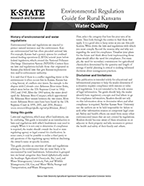Displaying 61 to 75 of 81 Publications
Environmental Regulation Guide for Rural Kansans
by Peter Tomlinson et al.
MF2890
Laws and regulations, which may affect landowners, can be confusing. This guide is intended as an introduction to laws and regulations with which landowners may need to comply. It should help the reader identify basic regulatory concepts and find where to go for compliance information. Includes agency contact information. 8-page, b/w.Revision Date: Jun 2017
Water Primer: Part 1, Overview
by G. Morgan Powell Danny H. Rogers Kerri Ebert
MF3020
Publication describes sources and uses of water in Kansas. 4 pages, color.Published Date: Mar 2012
Water Primer: Part 2, The Hydrologic Cycle
by Danny H. Rogers G. Morgan Powell Kerri Ebert
MF3021
The hydrologic cycle is nature’s water purification system. Its three main components are evaporation, precipitation, and runoff. 4 pages, color.Published Date: Mar 2012
Glossary of Water Terms
by G. Morgan Powell Kerri Ebert
MF2730
Waste Management Learning Center: Definitions of terms used in managing water quality. 8-page.Published Date: Aug 2007
Restoring a Flooded Well to Service
by G. Morgan Powell Danny H. Rogers Judith M. Willingham
MF2733
If flood water overtopped a well casing, polluted water and sediment likely entered the well and disinfection is essential. Equipment must be dried, cleaned, and checked.Published Date: Jun 2006
Atrazine Herbicide: A Water Quality Concern for Kansas
by Daniel L. Devlin David L. Regehr
MF2461
Atrazine herbicide runoff is entering Kansas surface waters. The maximum contaminant level (MCL) for atrazine had been set at an annual average of 3 parts per billion (ppb).Published Date: Aug 2000
Best Management Practices for Nitrogen
by Ray E. Lamond David A. Whitney Daniel L. Devlin
MF2202
Use optimum nitrogen amounts, apply no more than necessary. Use the right source of nitrogen for situation. Apply nitrogen at the right time, either as one application or split applications.Published Date: Apr 1996
Total Maximum Daily Loads
MF2459
If pollutants are found, a state is required to establish a Total Maximum Daily Load. A TMDL is the pollution a water body can receive without violating water quality standards.Published Date: Aug 2000
Comparing Irrigation Energy Costs
by Danny H. Rogers Mahbub Alam
MF2360
Shows comparisons between different irrigation energy costs. The selection of the irrigation fuel source is a significant decision; choices are electricity, natural gas, deisel, or propane.Revision Date: Aug 2006
Evaluating Pumping Plant Efficiency Using On-Farm Fuel Bills
by Danny H. Rogers Mahbub Alam
L885
Are irrigation costs are reasonable? Is irrigation is paying its way? Fuel bills have parts related to pumping plant performance and to crop and irrigation management.Revision Date: Jul 2006
Managing Groundwater Through Locally Led Group Conservation: A Guide for Producers
by Jonathan Aguilar Matthew Sanderson Stephen Lauer
MF3540
This publication provides an overview of locally led, group conservation tools available to Kansas producers and recommendations for organizing local group conservation efforts. 8 pages, color.Published Date: Jan 2021
Efficient Crop Water Use in Kansas
MF3066
Publication describes the climate of Kansas, tillage and residue effects on crops and soils, center pivot irrigation, water requirements, cropping systems, cover crops, row spacing, nutrients, and weed control. 44 p.Published Date: Aug 2012
Predicting the Final Irrigation for Corn, Grain Sorghum, and Soybeans
by Danny H. Rogers William M. Sothers
MF2174
To schedule final irrigation, the following information is needed: Current crop stage of growth. Predicted water use to maturity. Amount of usable water in root zone. Assume no rain occurs.Published Date: May 1996
Maintaining Drip Irrigation Systems
by Gary A. Clark William J. Lamont Charles W. Marr
MF2178
Drip irrigation systems are becoming more widely used, especially vegetable crops. The system must function efficiently during the entire growing season.Published Date: Apr 1996
Drip Irrigation for Vegetables
by Charles W. Marr Danny H. Rogers
MF1090
Drip irrigation is a method of applying small amounts of water,often on a daily basis,to the plant’s root zone.Revision Date: Oct 1993
Displaying 61 to 75 of 81 Publications
 Sign in
Sign in















